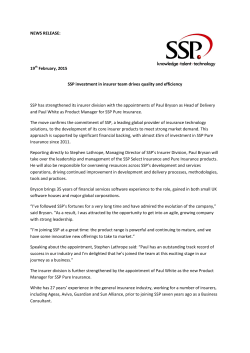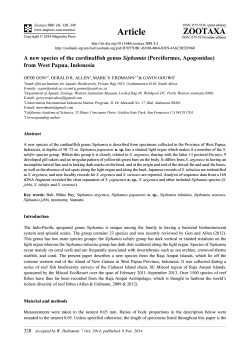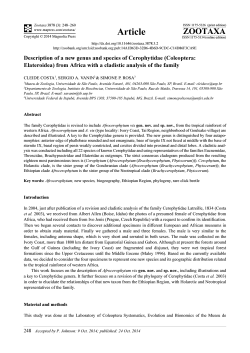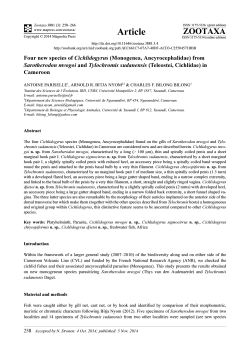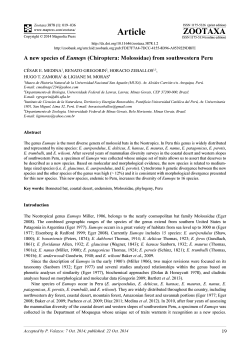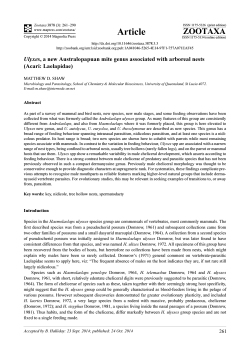
Preview - Magnolia Press
Zootaxa 3901 (1): 001–069 www.mapress.com /zootaxa / Copyright © 2014 Magnolia Press Monograph ISSN 1175-5326 (print edition) ZOOTAXA ISSN 1175-5334 (online edition) http://dx.doi.org/10.11646/zootaxa.3901.1.1 http://zoobank.org/urn:lsid:zoobank.org:pub:2E35E8C3-3D24-4350-BB8F-726FDD077BF2 ZOOTAXA 3901 New species of Centroderes (Kinorhyncha: Cyclorhagida) from the Northwest Atlantic Ocean, life cycle, and ground pattern of the genus BIRGER NEUHAUS1, FERNANDO PARDOS2, MARTIN V. SØRENSEN3 & ROBERT P. HIGGINS4 1 2 Museum für Naturkunde Berlin, Invalidenstr. 43, D-10115 Berlin, Germany, birger.neuhaus@mfn-berlin.de Department of Zoology and Anthropology (Invertebrate Zoology), Faculty of Biological Sciences, Universidad Complutense de Madrid, Antonio Novais, 2, 28040 Madrid, Spain, fpardos@bio.ucm.es 3 Natural History Museum of Denmark, University of Copenhagen, Øster Voldgade 5−7, DK-1350 Copenhagen, Denmark, mvsorensen@snm.ku.dk 4 400 Wesley Drive, Appt 454, Asheville, NC 28803, USA, rphigginsphd61@gmail.com Magnolia Press Auckland, New Zealand Accepted by Z.-Q. Zhang: 22 Oct. 2014; published: 24 Dec. 2014 BIRGER NEUHAUS, FERNANDO PARDOS, MARTIN V. SØRENSEN & ROBERT P. HIGGINS New species of Centroderes (Kinorhyncha: Cyclorhagida) from the Northwest Atlantic Ocean, life cycle, and ground pattern of the genus (Zootaxa 3901) 69 pp.; 30 cm. 24 Dec. 2014 ISBN 978-1-77557-607-5 (paperback) ISBN 978-1-77557-608-2 (Online edition) FIRST PUBLISHED IN 2014 BY Magnolia Press P.O. Box 41-383 Auckland 1346 New Zealand e-mail: zootaxa@mapress.com http://www.mapress.com/zootaxa/ © 2014 Magnolia Press All rights reserved. No part of this publication may be reproduced, stored, transmitted or disseminated, in any form, or by any means, without prior written permission from the publisher, to whom all requests to reproduce copyright material should be directed in writing. This authorization does not extend to any other kind of copying, by any means, in any form, and for any purpose other than private research use. ISSN 1175-5326 (Print edition) ISSN 1175-5334 (Online edition) 2 · Zootaxa 3901 (1) © 2014 Magnolia Press NEUHAUS ET AL Table of contents Abstract . . . . . . . . . . . . . . . . . . . . . . . . . . . . . . . . . . . . . . . . . . . . . . . . . . . . . . . . . . . . . . . . . . . . . . . . . . . . . . . . . . . . . . . . 3 Introduction . . . . . . . . . . . . . . . . . . . . . . . . . . . . . . . . . . . . . . . . . . . . . . . . . . . . . . . . . . . . . . . . . . . . . . . . . . . . . . . . . . . . . 3 Materials and methods . . . . . . . . . . . . . . . . . . . . . . . . . . . . . . . . . . . . . . . . . . . . . . . . . . . . . . . . . . . . . . . . . . . . . . . . . . . . 4 List of abbreviations . . . . . . . . . . . . . . . . . . . . . . . . . . . . . . . . . . . . . . . . . . . . . . . . . . . . . . . . . . . . . . . . . . . . . . . . . . . . . . 6 Results . . . . . . . . . . . . . . . . . . . . . . . . . . . . . . . . . . . . . . . . . . . . . . . . . . . . . . . . . . . . . . . . . . . . . . . . . . . . . . . . . . . . . . . 11 Centroderes barbanigra n. sp. . . . . . . . . . . . . . . . . . . . . . . . . . . . . . . . . . . . . . . . . . . . . . . . . . . . . . . . . . . . . . . . . . . . . . 11 Centroderes bonnyae n. sp. . . . . . . . . . . . . . . . . . . . . . . . . . . . . . . . . . . . . . . . . . . . . . . . . . . . . . . . . . . . . . . . . . . . . . . . . 21 Centroderes drakei n. sp. . . . . . . . . . . . . . . . . . . . . . . . . . . . . . . . . . . . . . . . . . . . . . . . . . . . . . . . . . . . . . . . . . . . . . . . . . . 27 Centroderes readae n. sp. . . . . . . . . . . . . . . . . . . . . . . . . . . . . . . . . . . . . . . . . . . . . . . . . . . . . . . . . . . . . . . . . . . . . . . . . . 39 Centroderes sp. . . . . . . . . . . . . . . . . . . . . . . . . . . . . . . . . . . . . . . . . . . . . . . . . . . . . . . . . . . . . . . . . . . . . . . . . . . . . . . . . . 55 Key to species of Centroderes . . . . . . . . . . . . . . . . . . . . . . . . . . . . . . . . . . . . . . . . . . . . . . . . . . . . . . . . . . . . . . . . . . . . . . 55 Discussion . . . . . . . . . . . . . . . . . . . . . . . . . . . . . . . . . . . . . . . . . . . . . . . . . . . . . . . . . . . . . . . . . . . . . . . . . . . . . . . . . . . . . 55 Acknowledgements . . . . . . . . . . . . . . . . . . . . . . . . . . . . . . . . . . . . . . . . . . . . . . . . . . . . . . . . . . . . . . . . . . . . . . . . . . . . . . 66 References . . . . . . . . . . . . . . . . . . . . . . . . . . . . . . . . . . . . . . . . . . . . . . . . . . . . . . . . . . . . . . . . . . . . . . . . . . . . . . . . . . . . . 66 Abstract Four new species of Centroderes are described from the Northwest Atlantic Ocean based on light microscopical observations of 153 adult and 26 juvenile specimens and on SEM investigations of 54 adult and 3 juvenile specimens. Centroderes barbanigra n. sp. and C. bonnyae n. sp. can be distinguished from all other species by the existence of a short lateroventral tube on segment 7. The latter species can be separated from the former by an acicular spine in the lateral accessory position on segment 8. The female of both C. readae n. sp. and C. spinosus possesses a female-specific, modified gland cell outlet on segments 7−9, but such an outlet is missing on segment 7 of all other species. The latter species is distinguished from the former by its robust lateroventral spine on segment 8 and by its lack of a laterodorsal sensory spot on segment 4, whereas the former species shows a midlateral sensory spot on segment 8. Centroderes drakei n. sp. agrees with the remaining American species in the possession of a laterodorsal sensory spot on segment 4; the former species can be distinguished from C. readae n. sp. by the lack of a sensory spot sublaterally on segment 1 and midlaterally on segment 8 as well as by the lack of a female-specific, modified gland cell outlet on segment 7; C. drakei n. sp. can be separated from C. barbanigra n. sp. and C. bonnyae n. sp. by its lack of a lateroventral tube on segment 7. We report anomalies rarely noticed for Kinorhyncha, such as different developmental artifacts in several specimens and a potential tumour in one individual. Evidence is provided that species of Centroderes develop via at least two adult life history stages, but three or more adult stages exist in C. drakei n. sp.; this represents the first record of a more complicated life cycle in Kinorhyncha. This paper also contains the first report of spermatophores in cyclorhagid Kinorhyncha and in both female and male specimens. In addition, characters in the ground pattern of Centroderes are summarized. Key words: Centroderes barbanigra n. sp., C. bonnyae n. sp., C. drakei n. sp., C. readae n. sp., taxonomy, tumour, spermatophore, development Introduction The first known species of Centroderes reveals a confusing history that was unveilled only recently (Neuhaus et al. 2013). Reinhard (1881) briefly describes and a few years later redescribes more extensively and also illustrates (Reinhard 1885, 1887) a new species, Echinoderes spinosus Reinhard, 1881. A couple of years later, Zelinka (1896) suggests a new family Centroderidae Zelinka, 1896 without assigning any species to this taxon. It takes another 11 years until Zelinka (1907) assigns a new genus name, Centroderes, to his family Centroderidae, and it is not before 1928, that E. spinosus is formally renamed Centroderes spinosus (Reinhard, 1881) in Zelinka’s monography of the Kinorhyncha (Zelinka 1928). In this important compilation, he also describes C. eisigii Zelinka, 1928 as new to science. The latter species differs from C. spinosus only by its lack of three dorsal acicular spines on segment 10 and by its smaller size, and it takes 85 years before Neuhaus et al. (2013) show that C. eisigii is actually the female, and hence a junior synonym, of C. spinosus. Unfortunately, Zelinka (1928) collects and describes not only species known from adult life history stages in his family Centroderidae, but also a range of CENTRODERES FROM THE NW ATLANTIC OCEAN Zootaxa 3901 (1) © 2014 Magnolia Press · 3 TABLE 10. Characters in the ground pattern of Centroderes. Features appearing exclusively in stage-1, stage-2, or unspecified females are marked in bold and put in [ ]. Characters existing only in stage-1, stage-2, or unspecified males are highlighted in italics and bold. position segment 1 2 3 4 5 6 7 8 md pd ac ac ac ac ac ac ac ac ssp ssp ssp ssp ssp ssp ssp ssp ssp ssp ssp ssp ssp ssp ssp ssp 9 ac ssp ssp ssp 10 [ac or – ]; ♂2 : cr ssp 11 ac + mts 3x ssp sd ld ml sl la lv ssp ssp vl vm long ac short tube ssp ssp ssp ssp ssp short tube ac; [gc] 1 ac ssp ssp ssp [gc] 1 [ac or – ]; ♂2 : cr ssp pa ssp; ltas lts ssp; gc 1 The position of the female-specific modified gland cell outlets is located more midventrally in C. spinosus than in the American species, so the table does not intend to mention the exact position of these gland cell outlets. Acknowledgements Specimens of Kinorhyncha have been kindly given on loan by Kathryn Ahlfeld, Cheryl Bright, and Dr Jon Norenburg; Susan Braden and Peter Walt Brown provided SEM services for BN while he was a postdoctoral fellow at the Smithsonian Institution, National Museum of Natural History, Washington, D.C.; this help is greatly appreciated. Several scientists and institutions supported collection of material, namely Bruce Coull, L. Pollock, Michael Rhodes, Marie Wallace, the Central Atlantic Benchmark Program, Texas A & M University, and Woods Hole. María Herranz, Complutense University, is deeply acknowledged for valuable help with SEM (FP) and discussions during the preparation of the material and manuscript. We also greatly appreciate the very careful comments by an anonymous reviewer and especially by Dr Nuria Sánchez. This work has been conducted with support through the SYNTHESYS Programme, financed by the European Community Research Infrastructure Action under the FP6 "Structuring the European Research Area Programme" to FP, by the Ministerio de Ciencia y Tecnología, Plan Nacional de Investigación Científica, Desarrollo e Investigación Tecnológica (Project No. CGL2009-08928) to FP, and by the Danish Natural Science Research Council (Grant No. 09-066003) to MVS. References Adrianov, A.V. & Malakhov, V.V. (1999) Cephalorhyncha of the world ocean. KMK Press Moscow, 328 pp. Adrianov, A.V., Murakami, C. & Shirayama, Y. (2002) Taxonomic study of the Kinorhyncha in Japan. II. Condyloderes setoensis, a new species (Kinorhyncha: Cyclorhagida) from Tanabe Bay (Honshu Island) - first representative of the genus in the Pacific Ocean. Proceedings of the Biological Society of Washington, 115, 205−216. Ax, P. & Armonies, W. (1987) Amphiatlantic identities in the composition of the boreal brackish water community of Plathelminthes. Microfauna Marina, 3, 7−80. Băcescu, M. (1968) Class Kinorhynch. Determination of the fauna of the Black and Azov Seas. Naukova Dumka, 1, 237−250. [in Russian] Băcescu, M. & Băcescu, E. (1956) Kinorhyncha representatives of a class of animal new to the Romanian fauna. Comunicarile Academiei RPR, 6 (4), 543−549. [in Romanian] Băcescu, M., Dumitrescu, E., Marcus, A., Paladian, G. & Mayer, R. (1963) Données quantitatives sur la faune pétricole de la Mer Noire à Agigea (secteur Roumain), dans les conditions spéciales de l’année 1961. Travaux du Muséum d’Histoire Naturelle “Grigore Antipa”, 4, 131−155. Bauer-Nebelsick, M. (1996) Antygomonas oreas sp. n., a new deep sea kinorhynch from the Pacific Ocean. Annalen des Naturhistorischen Museum Wien, 98B, 5−22. 66 · Zootaxa 3901 (1) © 2014 Magnolia Press NEUHAUS ET AL Coull, B.C. (1970) Shallow water meiobenthos of the Bermuda platform. Oecologia, 4, 325−357. http://dx.doi.org/10.1007/bf00393393 Diepenbroek, M., Grobe, H. & Sieger, R. (2000) PanMap. Available from: http://www.pangaea.de/Software/PanMap (access 31 March 2014) Heiner Bang-Berthelsen, I., Schmidt-Rhaesa, A. & Kristensen, R.M. (2013) 6. Loricifera. In: Schmidt-Rhaesa, A. (Ed.), Handbook of Zoology, Gastrotricha, Cycloneuralia and Gnathifera, Volume 1: Nematomorpha, Priapulida, Kinorhyncha, Loricifera. Walter de Gruyter, Berlin, pp. 349−371. http://dx.doi.org/10.1515/9783110272536.349 Herranz, M, Sánchez, N., Pardos, F. & Higgins, R.P. (2014) New Kinorhyncha from Florida coastal waters. Helgoland Marine Research, 68, 59−87. http://dx.doi.org/10.1007/s10152-013-0369-9 Higgins, R.P. (1964) A method for meiobenthic invertebrate collection. American Zoologist, 4 (3), 291. Higgins, R.P. (1965) The homalorhagid Kinorhyncha of Northeastern U. S. Coastal Waters. Transactions of the American Microscopical Society, 84 (1), 65−72. http://dx.doi.org/10.2307/3224541 Higgins, R.P. (1969) Indian Ocean Kinorhyncha: 1, Condyloderes and Sphenoderes, new cyclorhagid genera. Smithsonian Contributions to Zoology, 14, 1−13. http://dx.doi.org/10.5479/si.00810282.14 Higgins, R.P. (1974) Chapter 11. Kinorhyncha. In: Giese, A.C. & Pearce, J.S. (Eds.), Reproduction of marine invertebrates. Vol. I. Acoelomate and pseudocoelomate metazoans. Academic Press, New York, pp. 507−518. Higgins, R.P. (1977) Two new species of Echinoderes (Kinorhyncha) from South Carolina. Transactions of the American Microscopical Society, 96, 340−354. http://dx.doi.org/10.2307/3225864 Higgins, R.P. (1982) Three new species of Kinorhyncha from Bermuda. Transactions of the American Microscopical Society, 101(4), 305−316. http://dx.doi.org/10.2307/3225748 Higgins, R.P. (1983) The Atlantic Barrier Reef ecosystem at Carrie Bow Cay, Belize. II. Kinorhyncha. Smithsonian Contributions to Marine Science, 18, 1−131. http://dx.doi.org/10.5479/si.01960768.18.1 Higgins, R.P. (1986) Kinorhyncha. In: Sterrer, W. & Schöpfer-Sterrer, C. (Eds.), Marine Fauna and Flora of Bermuda: A systematic guide to the identification of marine organisms. John Wiley & Sons New York, pp. 220−222. Higgins, R.P. (1988) Kinorhyncha. In: Higgins, R.P. & Thiel, H. (Eds.), Introduction to the Study of Meiofauna. Smithsonian Institution Press Washington DC, pp. 328–331. Higgins, R.P. (1990) Zelinkaderidae, a new family of cyclorhagid Kinorhyncha. Smithsonian Contributions to Zoology, 500, 1−26. http://dx.doi.org/10.5479/si.00810282.500 Higgins, R.P. & Fleeger, J.W. (1980) Seasonal changes in the population structure of Echinoderes coulli (Kinorhyncha). Estuarine and Coastal Marine Science, 10, 495−505. http://dx.doi.org/10.1016/s0302-3524(80)80071-5 Higgins, R.P. & Storch, V. (1991) Evidence for direct development in Meiopriapulus fijiensis (Priapulida). Transactions of the American Microscopical Society, 110, 37−46. http://dx.doi.org/10.2307/3226738 Hooper, D.J. (1970) Handling, fixing and mounting nematodes. In: Southey, J.F. (Ed.), Laboratory methods for work with plant and soil nematodes. Ministry of Agriculture, Fisheries and Food, Technical Bulletin 2. Her Majesty’s Stationary Office London, pp. 39−54. Hummon, W.D. & Kelly, J.L. (2011) Turbanella amphiatlantica, a new species of Gastrotricha (Macrodasyida) from eastern North America and northwest europe. Meiofauna Marina, 18, 61−70. ICZN (1999) International Code of Zoological Nomenclature. 4th Edition. The Natural History Museum, London, 306 pp. http://dx.doi.org/10.5962/bhl.title.50608 Kornicker, L.S. (1976) Removal of gelatinous coating from the surface of the carapace of Ostracoda in preparation for their examination with the scanning electron microscope. Proceedings of the Biological Society of Washington, 89, 365−368. Land, J. van der (1970) Systematics, zoogeography, and ecology of the Priapulida. Zoologische Verhandelingen, 112, 1−118. Lang, K. (1939) Über die Entwicklung von Priapulus caudatus Lam. (Vorläufige Mitteilung). Kungl. Fysiografiska Sällskapets i Lund Förhandlingar, 9 (7), 1−8. Leasi, F. & Todaro, M.A. (2009) Meiofaunal cryptic species revealed by confocal microscopy: The case of Xenotrichula intermedia (Gastrotricha). Marine Biology, 156, 1335−1346. http://dx.doi.org/10.1007/s00227-009-1175-4 Marinov, T. (1964) On the microzoobenthos fauna of the Black Sea (Kinorhyncha and Halacaridae). Bulletin of the Institute of Fish-Culture and Fisheries Varna, 4, 61−71. [in Bulgarian] Martorelli, S. & Higgins, R.P. (2004) Kinorhyncha from the stomach of the shrimp Pleoticus muelleri (Bate, 1888) from Comodoro Rivadavia, Argentina. Zoologischer Anzeiger, 243, 85−98. CENTRODERES FROM THE NW ATLANTIC OCEAN Zootaxa 3901 (1) © 2014 Magnolia Press · 67 http://dx.doi.org/10.1016/j.jcz.2004.07.003 Nebelsick, M. (1992) Sensory spots of Echinoderes capitatus (Zelinka, 1928) (Kinorhyncha, Cyclorhagida). Acta Zoologica, 73, 185−195. http://dx.doi.org/10.1111/j.1463-6395.1992.tb01186.x Neuhaus, B. (1993) Postembryonic development of Pycnophyes kielensis and P. dentatus (Kinorhyncha) from the North Sea. Microfauna Marina, 8, 163−193. Neuhaus, B. (2003) 19. Kinorhyncha. In: Hofrichter, R. (Ed.), Das Mittelmeer - Fauna, Flora, Ökologie, Bd. II/1 Bestimmungsführer Prokaryota, Protista, Fungi, Algae, Plantae, Animalia (bis Nemertea). Spektrum Akademischer Verlag Heidelberg, pp. 646−653. Neuhaus, B. (2013) 5. Kinorhyncha (= Echinodera). In: Schmidt-Rhaesa, A. (Ed.), Handbook of Zoology, Gastrotricha, Cycloneuralia and Gnathifera. Vol. 1. Nematomorpha, Priapulida, Kinorhyncha, Loricifera. Walter de Gruyter Berlin, pp. 177−348. http://dx.doi.org/10.1515/9783110272536.181 Neuhaus, B. & Higgins, R.P. (2002) Ultrastructure, biology, and phylogenetic relationships of Kinorhyncha. Integrative and Comparative Biology, 42, 619−632. http://dx.doi.org/10.1093/icb/42.3.619 Neuhaus, B. & Kegel, A. (2014) Redescription of Cateria gerlachi (Kinorhyncha: Cyclorhagida) from Sri Lanka and of C. styx from Brazil, with notes on C. gerlachi from India and C. styx from Chile, and ground pattern of the genus. Zootaxa. [submitted] Neuhaus, B., Pardos F., Sørensen, M.V. & Higgins, R.P. (2013) Redescription, morphology, and biogeography of Centroderes spinosus (Reinhard, 1881) (Kinorhyncha, Cyclorhagida) from Europe. Cahiers de Biologie Marine 54, 109−131. http://dx.doi.org/10.1016/j.jcz.2012.03.002 Neuhaus, B. & Sørensen, M.V. (2013) Populations of Campyloderes sp. (Kinorhyncha, Cyclorhagida): one global species with significant morphological variation? Zoologischer Anzeiger, 252, 48−75. http://dx.doi.org/10.1016/j.jcz.2012.03.002 Nyholm, K.-G. (1947) Studies in the Echinoderida. Arkiv för Zoologi, 39 A (14), 1−36, pls. I−II. Ostmann, A., Nordhaus, I. & Sørensen, M.V. (2012) First recording of kinorhynchs from Java, with the description of a new brackish water species from a mangrove-fringed lagoon. Marine Biodiversity, 42, 79−91. http://dx.doi.org/10.1007/s12526-011-0094-z Pardos, F., Higgins, R.P. & Benito, J. (1998) Two new Echinoderes (Kinorhyncha, Cyclorhagida) from Spain, including a reevaluation of Kinorhynch taxonomic characters. Zoologischer Anzeiger, 237, 195−208. Pardos, F. & Kristensen, R.M. (2013) First record of Loricifera from the Iberian Peninsula with the description of Rugiloricus manuelae sp. nov., (Loricifera, Pliciloricidae). Helgoland Marine Research, 67, 623−628. http://dx.doi.org/10.1007/s10152-013-0349-0 Por, F.D. & Bromley, H.J. (1974). Morphology and anatomy of Maccabeus tentaculatus (Priapulida: Seticoronaria). Journal of Zoology (London), 173, 173−197. http://dx.doi.org/10.1111/j.1469-7998.1974.tb03125.x Purasjoki, K.J. (1944) Beiträge zur Kenntnis der Entwicklung und Ökologie der Halicryptus spinulosus-Larve (Priapulida). Annales Zoologici Societatis Zoologicæ-Botanicæ Fennicæ, 9 (6), 1−14. Reinhard, W. (1881) Über Echinoderes and Desmoscolex der Umgegend von Odessa. Zoologischer Anzeiger, 4, 588−592. Reinhard, W. (1885) Kinorhyncha (Echinoderes), leur structure anatomique et leur place dans le système. Travaux de la Société des naturalistes à l’Université Impériale de Kharkow, 19, 205−305. [in Russian] Reinhard, W. (1887) Kinorhyncha (Echinoderes) ihr anatomischer Bau und ihre Stellung im System. Zeitschrift für Wissenschaftliche Zoologie, 45, 401−467. Remane, A. (1929) Dritte Klasse des Cladus Nemathelminthes: Kinorhyncha = Echinodera. In: Krumbach, T. (Ed.), Handbuch der Zoologie, Zweiter Band Amera, Erste Hälfte, 6. Lieferung. W. de Gruyter, Berlin, pp. 187−248. Ruppert, E.E. (1977) Zoogeography and speciation in marine Gastrotricha. Mikrofauna des Meresbodens, 61, 231−251. Schmidt, H. & Westheide, W. (1999) Genetic relationships (RAPD-PCR) between geographically separated populations of the „cosmopolitan“ interstitial polychaete Hesionides gohari (Hesionidae) and the evolutionary origin of the freshwater species Hesionides riegerorum. Biological Bulletin, 196, 216−226. http://dx.doi.org/10.2307/1542567 Schmidt, H. & Westheide, W. (2000) Are the meiofaunal polychaetes Hesionides arenaria and Stygocapitella subterranea true cosmopolitan species? - results of RAPD-PCR investigations. Zoological Scripta, 29, 17−27. http://dx.doi.org/10.1046/j.1463-6409.2000.00026.x Schmidt-Rhaesa, A. (2013) 4. Priapulida. In: Schmidt-Rhaesa, A. (Ed.), Handbook of Zoology, Gastrotricha, Cycloneuralia and Gnathifera. Vol. 1. Nematomorpha, Priapulida, Kinorhyncha, Loricifera. Walter de Gruyter, Berlin, pp. 147−180. http://dx.doi.org/10.1515/9783110272536.147 Schmitz, W.J. (1996a) On the world ocean circulation. Vol. I. Some global features, North Atlantic circulation. Woods Hole Oceanographic Institution Technical Report, WHOI-96-03, 140 pp. Schmitz, W.J. (1996b) On the world ocean circulation. Vol. II. The Pacific and Indian Oceans, a global update. Woods Hole Oceanographic Institution Technical Report, WHOI-96-08, 237 pp. 68 · Zootaxa 3901 (1) © 2014 Magnolia Press NEUHAUS ET AL Scotese, C.R. (1991) Jurassic and Cretaceous plate tectonic reconstructions. Palaeogeography, Palaeoclimatology, Palaeoecology, 87, 493−501. http://dx.doi.org/10.1016/0031-0182(91)90145-h Sheremetevskij, A.M. (1974) Kinorhyncha of the Black Sea. Zoologhiceskii Zhurnal, 53, 974−987. Soosten, C. von, Schmidt, H. & Westheide, W. (1998) Genetic variability and relationships among geographically widely separated populations of Petitia amphophthalma (Polychaeta: Syllidae). Results from RAPD-PCR investigations. Marine Biology, 131, 659−669. http://dx.doi.org/10.1007/s002270050358 Sørensen, M.V., Heiner, I. & Hansen, J.G. (2009) A comparative morphological study of the kinorhynch genera Antygomonas and Semnoderes (Kinorhyncha: Cyclorhagida). Helgoland Marine Research, 63, 129−147. http://dx.doi.org/10.1007/s10152-008-0132-9 Sørensen, M.V., Herranz, M., Rho, H.S., Min, W.-G., Yamasaki, H., Sánchez, N. & Pardos, F. (2012) On the genus Dracoderes Higgins & Shirayama, 1990 (Kinorhyncha: Cyclorhagida) with a redescription of its type species, D. abei, and a description of a new species from Spain. Marine Biology Research, 8, 210−232. http://dx.doi.org/10.1080/17451000.2011.615328 Sørensen, M.V. & Pardos, F. (2008) Kinorhynch systematics and biology - an introduction to the study of kinorhynchs, inclusive identification keys to the genera. Meiofauna Marina, 16, 21−73. Sørensen, M.V., Rho, H.S. & Kim, D. (2010) A new species of Condyloderes (Cyclorhagida, Kinorhyncha) from Korea. Zoological Science, 27, 234−242. http://dx.doi.org/10.2108/zsj.27.234 Sørensen, M.V. & Thormar, J. (2010) Wollunquaderes majkenae gen. et sp. nov. - a new cyclorhagid kinorhynch genus and species from the Coral Sea, Australia. Marine Biodiversity, 40, 261−275. http://dx.doi.org/10.1007/s12526-010-0048-x Sterrer, W. (1973) Plate tectonics as a mechanism for dispersal and speciation in interstitial sand fauna. Netherlands Journal of Sea Research, 7, 200−222. http://dx.doi.org/10.1016/0077-7579(73)90045-8 Stampfli, G.M. & Borel, G.D. (2002) A plate tectonic model for the Paleozoic and Mesozoic constrained by dynamic plate boundaries and restored synthetic oceanic isochrons. Earth and Planetary Science Letters, 196, 17−33. http://dx.doi.org/10.1016/s0012-821x(01)00588-x Todaro, M.A., Fleeger, J.W., Hu, Y.P., Hrincevich, A.W. & Foltz, D.W. (1996) Are meiofauna species cosmopolitan? Morphological and molecular analysis of Xenotrichula intermedia (Gastrotricha: Chaetonotida). Marine Biology, 125, 735−742. http://dx.doi.org/10.1007/bf00349256 Westheide, W. (1977) The geographical distribution of interstitial polychaetes. Mikrofauna des Meresbodens, 61, 287−302. Westheide, W. (1987) The interstitial polychaete Hesionides pettiboneae n. sp. (Hesionidae) from the U.S. east coast and its transatlantic relationships. Biological Society of Washington Bulletin, 7, 131−139. Westheide, W. & Purschke, G. (1988) 10. Organism processing. In: Higgins, R.P. & Thiel, H. (Eds.), Introduction to the study of meiofauna. Smithsonian Institution Press Washington, D.C., pp. 146−160. Westheide, W. & Rieger, R.M. (1987) Systematics of the amphiatlantic Microphthalmus-listensis-species-group (Polychaeta: Hesionidae): Facts and concepts for reconstruction of phylogeny and speciation. Zeitschrift für zoologische Systematik und Evolutionsforschung, 25, 12−39. http://dx.doi.org/10.1111/j.1439-0469.1987.tb00911.x Zelinka, K. (1896) Demonstration von Tafeln der Echinoderes-Monographie. Verhandlungen der Deutschen Zoologischen Gesellschaft, 6, 197−199. Zelinka, K. (1907) Zur Kenntnis der Echinoderen. Zoologischer Anzeiger, 32, 130−136. Zelinka, K. (1928) Monographie der Echinodera. Verlag Wilhelm Engelmann, Leipzig, 396 pp. CENTRODERES FROM THE NW ATLANTIC OCEAN Zootaxa 3901 (1) © 2014 Magnolia Press · 69
© Copyright 2025


